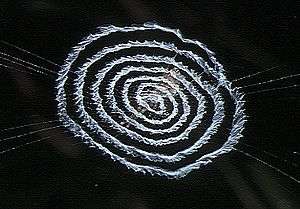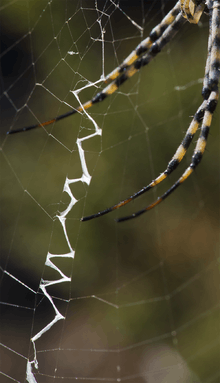Web decoration

A web decoration or stabilimentum (plural: stabilimenta) is a conspicuous silk structure included in the webs of some species of orb-web spider. Its function is a subject of debate.

Origin
It is likely that the use of stabilimenta evolved independently at least nine different times. Araneus and Gasteracantha make silk stabilimenta, while Cyclosa and the closely related Allocyclosa bifurca make stabilimenta of silk, detritus, and their egg sacs. All those evolved independently from those of Argiope, although some decorations of Allocyclosa bifurca closely resemble those of Argiope.[1]
Form

Although web decorations are common in a number of spider species in the families Araneidae, Tetragnathidae and Uloboridae, they are probably best known from spiders of the genus Argiope. This genus includes a number of species known as the Saint Andrew's Cross spiders, so named for their habit of resting in their webs with their legs outstretched in the shape of an X, the traditional shape of the cross of Saint Andrew. Spiders in this genus also construct web decorations as a vertical line, and juveniles commonly construct disc-shaped decorations.[2] Other spiders construct round structures covering the entire hub of the web.
Function

There is much controversy surrounding the function of these structures, and it is likely that different species use it for different purposes. It has been suggested that they could provide protection to the spider by either camouflaging it or making it appear larger.[3] Another theory is that they make the spider visible and therefore animals such as birds are less likely to damage the spider’s web.[4] Originally the decorations were thought to stabilize the web (hence the term stabilimentum),[5] though this theory has since been dismissed. One more recent theory is that web decorations attract prey by reflecting ultraviolet light.[6] Light in the ultraviolet part of the spectrum is known to be attractive to many species of insects.[6] Many other theories have also been proposed such as thermoregulation, stress, regulation of excess silk, or simple aesthetics. At least one variant has been observed to vibrate the web, while positioned in the stabilimentum, when approached by a body the size of a human. Another theory is camouflage as it breaks up the outline of the spider. One theory has been put forward that the purpose of the stabilimentum is to attract the male of the species to the web when the female is ready to reproduce. A limited study carried out in the Calahonda area of Spain in the summer of 1992 showed that there was a positive correlation between the presence of a male in the webs of Argiope lobata and the presence of a stabilimentum.[7] These webs can also be found to be used by Arigiope species including Argiope bruennichi
While many Uloborus species construct stabilimenta, Uloborus gibbosus does not; it usually rests at an edge of its orb and drops to the ground if disturbed. This is thought to support the web camouflage hypothesis. The strongly UV-reflecting stabilimentum of the uloborid Octonoba sybotides was found to be attractive to Drosophila flies.[1]
Materials
While the most conspicuous and well-studied decorations are constructed entirely of silk (for example in Argiope), some spiders combine silk with other items such as egg sacs and debris (for example in Cyclosa). It seems likely that these decorations camouflage the spider, thus providing protection against predators.[8] However, one interesting case occurs in some species of the golden orb spiders in the genus Nephila. These spiders commonly attach lines of uneaten prey items to their webs. Recent studies have shown that these items help the spider to attract more prey.[9]
Stabilimenta in popular culture
It is claimed that E. B. White came up with the idea of a writing spider for his book Charlotte's Web after observing stabilimenta in a spider web.[10][11]
See also
Footnotes
- 1 2 Eberhard 2006
- ↑ Bruce & Herberstein 2005
- ↑ Schoener & Spiller 1999
- ↑ Herberstein et al. 2000; Bruce 2006; Eisner & Nowicki 1983
- ↑ Robinson & Robinson 1970
- 1 2 Craig & Bernard 1990
- ↑ Tickner 1992 (unpublished)
- ↑ Eberhard 2003
- ↑ Bjorkman-Chiswell et al. 2004
- ↑ America's Wetland Foundation: Garden Spiders
- ↑ BugGuide.Net: Family Araneidae - Orb Weavers
References
- Bjorkman-Chiswell, Bojun T.; Kulinski, Melissa M.; Muscat, Robert L.; Nguyen, Kim A.; Norton, Briony A.; Symonds, Matthew R.E.; Westhorpe, Gina E. & Elgar, Mark A. (2004): Web-building spiders attract prey by storing decaying matter. Naturwissenschaften 91: 245-248. doi:10.1007/s00114-004-0524-x
- Bruce, M.J. & Herberstein, Marie E. (2005): Web decoration polymorphism in Argiope Audouin, 1826 (Ananeidae) spiders: ontogenetic and interspecific variation. Journal of Natural History 44: 3833-3845. PDF
- Bruce, M.J. (2006): Silk decorations controversy and consensus. Journal of Zoology 269: 89-97. doi:10.1111/j.1469-7998.2006.00047.x
- Craig, Catherine L. & Bernard, Gary D. (1990): Insect attraction to ultraviolet-reflecting spider webs and web decorations. Ecology 71: 616-623. doi:10.2307/1940315
- Eberhard, William G. (2003): Substitution of silk stabilimenta for egg sacks by Allocyclosa bifurca (Araneae: Araneidae) suggests that silk stabilimenta function as camouflage devices. Behaviour 140: 847-868. doi: 10.1163/156853903770238346
- Eberhard, William G. (2006): Stabilimenta of Philoponella vicina (Araneae: Uloboridae) and Gasteracantha cancriformis (Araneae: Araneidae): Evidence Against a Prey Attractant Function. Biotropica 39(2): 216-220. doi:10.1111/j.1744-7429.2006.00254.x
- Eisner, T. & Nowicki, S. (1983): Spider-Web Protection Through Visual Advertisement: Role of the Stabilimentum. Science 14 January 1983
- Robinson, M.J. & Robinson, B (1970): Stabilimentum of orb web spider, Argiope argentata: an improbable defence against predators. Canadian Entomologist 102: 641-655. doi:10.4039/Ent102641-6
- Schoener, T.W. & Spiller, D.A. (1992): Stabilimenta characteristics of the spider Argiope argentata on small islands: support of the predator-defense hypothesis. Behavioral Ecology and Sociobiology 31: 309-318. doi:10.1007/BF00177771
Further reading
- Blackledge, T.A. & Wenzel, J.W. (1999): Do stabilimentum in orb webs attract prey or defend spiders? Behavioral Ecology 10(4): 372-376.
- Starks, P.T. (2002): The adaptive significance of stabilimentum in orb-webs: a hierarchical approach. Annals of Zoology 39: 307-315.
External links
| Wikimedia Commons has media related to Stabilimentum. |
| |||||||||||||||||||||||||||||
